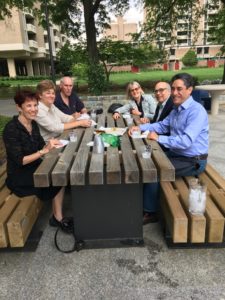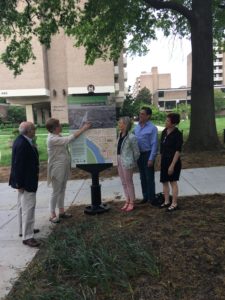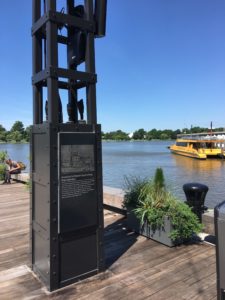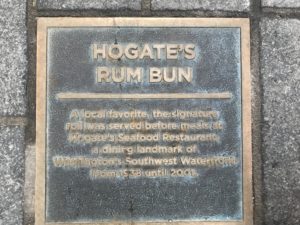




Soon after Hoffman-Madison Waterfront (HMW) was awarded the opportunity to redevelop the Southwest Waterfront by the DC government in 2007, HMW was approached by a group of Southwest community members to discuss ways in which HMW could incorporate into the development the rich history of Southwest DC, the Waterfront, and the Municipal Fish Market—the longest continuously operating, outdoor fish market in the country.
HMW agreed, so we began to explore ways to work collaboratively with the community to honor this history. The results of the developer-community partnership that grew from an initial meeting are extraordinary and include:
- a new cultural tourism Heritage Trail sign adjacent to Tiber Island and Waterfront Park that honors the mid-century modern architecture of Southwest;
- pavement markers throughout The Wharf plazas, promenades, sidewalks, and bollard panels on District Pier honoring individuals, structures, and events at The Wharf over the history of DC; and
- historic designation and renovation of the fish cleaning building and oyster shack at the Fish Market and its re-use of the building as a restaurant, the Rappahannock Oyster Company.
A small celebration to honor the completion and installation of the Heritage Trail sign was held on May 10, during which HMW acknowledged and commemorated the long and dedicated effort of the community, in partnership with The Wharf, EHT Traceries, and Cultural Tourism DC, to develop and implement the overall heritage program at The Wharf.
Carolyn Crouch, founder of Washington Walks, an organization that leads tours of DC focusing on its history, commented, “As a member of the original Southwest Heritage Trail working group that developed the content for the River Farms to Urban Towers signs, I was delighted to be able to participate again in creating this newest sign celebrating the history of the site where Tiber Island was built. Like many of the other signs seen on our Heritage Trail, this most recent addition does double duty. It points out the high quality of design that defined much of the urban renewal–era architecture in Southwest while also paying tribute to what was lost when whole-scale change came to the neighborhood in the 1960s.”
To celebrate the installation, members of the Heritage Trail Sign Committee and Cultural Tourism DC gathered in Waterfront Park, also designed by the community in collaboration with HMW and its landscape architect, Nelson Byrd Woltz, to view the new Heritage Trail sign, partake in Perrier and Dolcezza cookies, and reflect on the effort.
During the celebration, Cultural Tourism DC Executive Director Steven Shulman shared, “We’re delighted that the River Farms to Urban Towers: Southwest DC Neighborhood Heritage Trail has become a treasured neighborhood amenity. It’s wonderful that community leaders and District Wharf selected it for helping people learn about mid–20th century modern architecture and its important role in the neighborhood.”
Cultural tourism DC Heritage Trail sign: Early on, the Southwest Heritage group requested that HMW fund the development, fabrication, and installation of a cultural tourism Heritage Trail sign on mid-century modernism, to be added to the existing River Farms to Urban Towers Southwest Heritage Trail. Members of the group included Steven Shulman, Carolyn Crouch, history consultant Mara Cherkasky, and Single Member District ANC Commissioner Andy Litsky, as well as ANC Commissioner Gail Fast, District Wharf Partner Elinor Bacon, and Wharf Community Association President Bob Rubenkonig. Other community members who contributed their time, passion, and knowledge about the history of the Southwest to this project included Eric Jenkins, Bruce Levine, Paul Greenberg, and Marjorie Lightman.
Following more than a year of meetings, the group reached a consensus on the photos, text, and location for the sign that will greet community members and visitors at Waterfront Park, as well as history buffs following the Southwest Heritage Trail and those led by Washington Walks, in its walking tours through the Southwest. HMW has carefully stored the Heritage Trail signs that were taken down for the construction of The Wharf’s first phase of construction. They will be re-installed in the coming months. The group hopes funding will be identified to link the Southwest Heritage Trail to the Capitol Hill Heritage Trail, to highlight both the positive and negative effects of urban renewal and the redevelopment efforts now underway in Southwest and Near-Southeast to knit new development into the neighborhood’s fabric, resulting in more human-scale, mixed-use, mixed-income neighborhoods.
Sidewalk markers and District Pier bollard panels featuring the history of The Wharf: In an effort also spurred by the Southwest Community and led by Bacon and Rubenkonig—along with the talents, expertise, and support of EHT Traceries, led by President Emily Eig—a separate community group, appointed by ANC 6D commissioners, worked for more than a year to identify and research noteworthy individuals, events, and structures at The Wharf throughout history. Many ideas were considered, and the group pared down the list to 26 sidewalk markers and 10 engraved panels to be installed on the District Pier bollards. For each marker and panel, the committee had detailed discussions of wording, images, and location, etc. HMW plans to develop a phone app that will elaborate on the subject of each of the markers to tell the full story of the historic event, place, or person highlighted.
Fish cleaning building: Although commonly referred to as the fish cleaning building, it was actually two buildings: a lunch room for fishermen and market workers and an open oyster shucking shed that had been joined in the 1940s with an unsightly addition to serve as a public restaurant. The lunch room and shed were once part of the Municipal Fish Market, built in 1916-1918 as pre–home rule project of the DC municipal government and Congress. HMW believed it was critical to preserve and honor these buildings, although they were in almost irretrievable condition. HMW worked in partnership with the DC Office of Preservation, historic preservation specialist EHT Traceries, and architecture firm StudioMB to landmark the buildings and restore them consistently with the historic standards required. The historically rehabilitated buildings will soon open as the Rappahannock Oyster Company, an exciting new restaurant specializing in fish and oysters—a most fitting future for these historic resources.
Eig, an architectural historian and historic preservation specialist with EHT Traceries who participated in various aspects of the project for many years, is excited about how the area’s history was documented and how it is being remembered: “The united efforts of the community and HMW to research, document, and commemorate the history of The Wharf and the Fish Market ensures that the area’s heritage is permanently incorporated into this exciting new destination on the Washington Channel. Anyone who visits—whether tourist, student, visitor, or resident—cannot help but discover that The Wharf has a vibrant history…lively, long, significant, and well worth remembering!”
HMW is proud and pleased to have worked with the community, local historians and consultants, Cultural Tourism DC, and the District to preserve and honor the rich history of the Southwest Waterfront.
Litsky thoughtfully sums up the Heritage Program: “As one walks along the gleaming new structures at The Wharf, it is remarkable to see how much thought and attention has been devoted to properly acknowledging the past. The Wharf Heritage Program provides a distinct sense of place and ensures that two centuries of our own neighborhood history will be celebrated for many years to come.”
By: Elinor Bacon and Caroline Crawford

